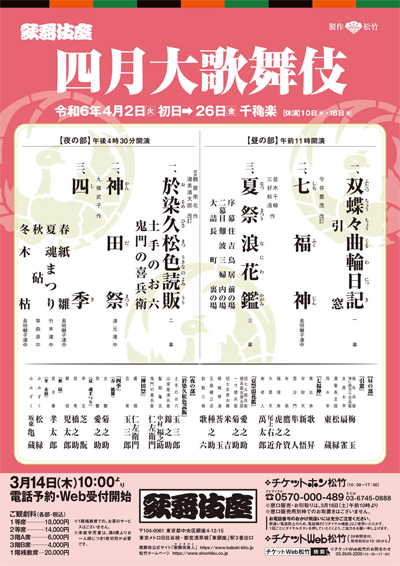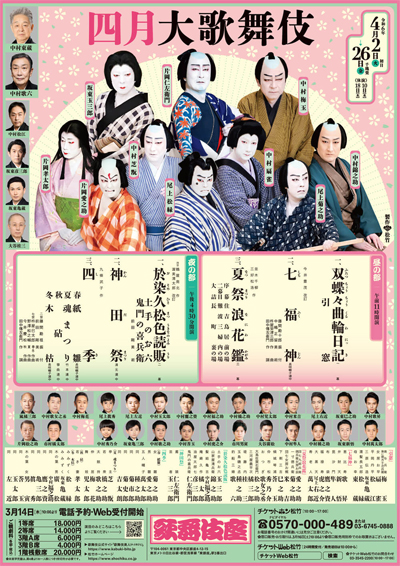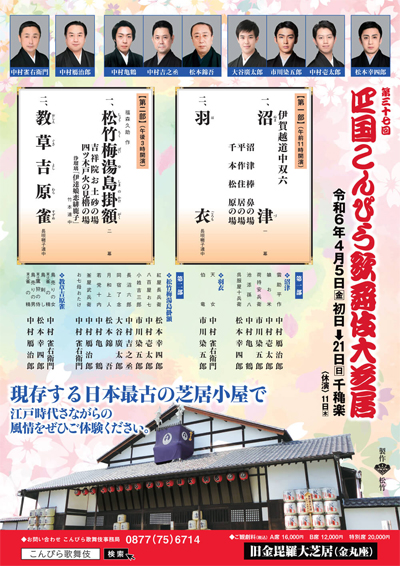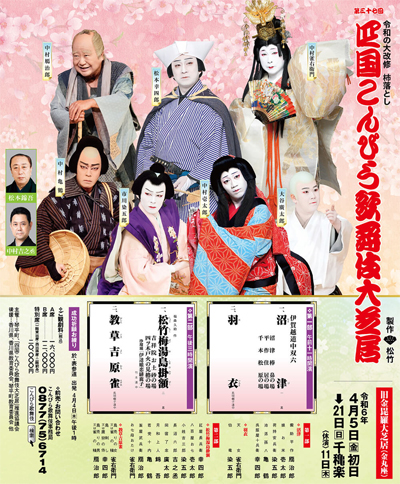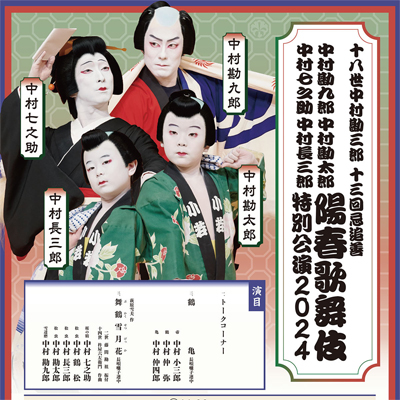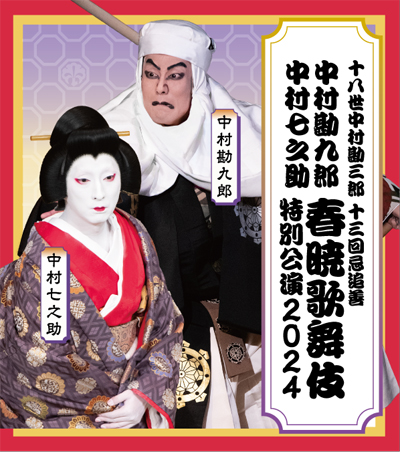| Dates |
2 ~ 26 April 2024
Shigatsu ďkabuki
April Grand Kabuki |
| MatinÚe |
Futatsu Ch˘ch˘ Kuruwa Nikki (Hikimado)
Shichi Fukujin
Natsu Matsuri Naniwa Kagami
Sumiyoshi Torii Mae
Tsuribune Sabu Uchi
Nagamachi Ura
|
| Evening |
Osome Hisamatsu Ukina no Yomiuri
(Dote no Oroku ~ Kimon no Kihŕ)
Kanda Matsuri
Shiki
Haru ~ Kamibina
Natsu ~ Tama Matsuri
Aki ~ Kinuta
Fuyu ~ Kogarashi
|
| Casting |
Living National Treasure Kataoka Nizaemon, Living National Treasure Band˘ Tamasabur˘, Living National Treasure Nakamura Baigyoku, Living National Treasure Nakamura Karoku, Living National Treasure Nakamura T˘z˘, Nakamura Shikan, Nakamura Senjaku, Onoe Kikunosuke, Kataoka Ainosuke, Kataoka Takatar˘, Onoe Sh˘roku, Nakamura Kinnosuke, Nakamura Hayato, Band˘ Minosuke, Band˘ Hikosabur˘, Band˘ Kamez˘, Nakamura Kotar˘, Onoe Ukon,
Nakamura Matsue, Nakamura Hashinosuke, Nakamura Kash˘, Nakamura Yonekichi, Nakamura Takanosuke, Nakamura Kangyoku, Nakamura Mantar˘, Nakamura Tanenosuke, Nakamura Toranosuke, Band˘ Shingo, Nakamura Fukunosuke, Nakamura Utanosuke,
ďtani Keiz˘, ďtani Hiromatsu, Onoe Sakon, Nakamura Tamatar˘, Ichikawa Otora, Onoe Maholo, Arashi Kitsusabur˘, Ichimura Kitsutar˘, Nakamura Kamenoj˘, Nakamura Baika, Kataoka Matsunosuke, Band˘ Kamesabur˘, Nakamura Hidenosuke
|
| Comments |
The April Grand Kabuki at the Kabukiza.
Hikimado: originally written for the puppet theater,
this play shows a tragedy of commoners caught between their duty and their
feelings toward their loved ones. A sum˘
wrestler named Nuregami Ch˘gor˘ (Onoe Sh˘roku)
has killed a man and takes refuge at the home of his mother.
Unfortunately, her son (Living National Treasure Nakamura Baigyoku) has been ordered to arrest him.
All of these complicated conflicts are symbolized by the lightness and
darkness created by the humble skylight (hikimado in Japanese)
as a rope is pulled to move a wooden shutter. Featuring also Nakamura Senjaku in the role of Ohaya.
Shichi Fukujin:
(The Seven Gods of Good Fortune)
A treasure ship on which the Seven Gods of Good Fortune pose
appears on the waves. They get excited after toasting again and again. They portray a courtesan and her lover in the pleasure quarters
in dance and then dance praying for peace across the land. Featuring 7 young actors.
Natsu Matsuri: this grisly murder story became a smashing hit
when it was first performed in 1745 because of the chivalrous spirit of the
many ďsaka characters appearing in this story, the contrast between a brutal murder
and the jovial mood of a summer festival, and the splashing of real water
used on the stage. Danshichi, a gallant fishmonger, does everything he can to protect
the weak young son of his patron with the help of his companion Tokubŕ
and the older Sabu. Although even Tokubŕ's wife Otatsu heroically helps out,
in the end, Danshichi is betrayed by his evil father-in-law Giheiji and,
in the most famous scene of the play, must kill him in a mud-covered fight
in a lonely alley with the shouts of the local festival nearby.
This program stars Kataoka Ainosuke as Danshichi,
with Onoe Kikunosuke, Living National Treasure Nakamura Karoku, Arashi Kitsusabur˘ and Kataoka Ainosuke as Issun Tokubŕ, Tsuribune Sabu, Mikawaya Giheiji and Otatsu.
Dote no Oroku/Kimon no Kihŕ: this is a play written by Tsuruya Nanboku IV,
and these scenes in particular reflect the decadence and corruption found in the underbelly of ordinary society
at that time. The scenes portray two outwardly charming characters who are filled with wickedness.
There are several typical role types that appear in Kabuki, and akuba (wicked lady)
is one of them. Oroku is an akuba and although beautiful,
she is truly wicked. Trying to extort 100 gold coins, Oroku and her husband Kimon no Kihŕ visit a pawnshop carrying the
dead body of Oroku's brother. The two insist that her brother died from an injury he incurred in a
quarrel with its apprentice. However, the dead body suddenly becomes conscious and the extortion ends in failure.
Although disappointed, the two leave the pawnshop without flinching in the slightest.
Starring Living National Treasures Band˘ Tamasabur˘ and Kataoka Nizaemon in the roles of Oroku and Kihŕ.
Featuring also Nakamura Kinnosuke and Band˘ Hikosabur˘.
Kanda Matsuri:
(The Kanda Festival)
The gallant commoners of Edo's neighborhoods loved nothing better than a festival, and this performance is a dance based on one of the biggest festivals in Edo (Kanda Matsuri).
In this dance, a gallant fireman (Living National Treasure Kataoka Nizaemon) and a geisha (Living National Treasure Band˘ Tamasabur˘) appear on stage and display their 'Edo-style' spirit. In the end, a young man comes out and a beautiful fighting scene unfolds on stage.
Shiki: this dance portrays the four seasons in Japan beautifully. Paper dolls representing a happy couple in spring,
the emotional dance of a young proprietor and others against the background of giant bonfires on the mountainside in summer,
a young wife who thinks of her husband in autumn, as a poem by Li Po describes, as well as whirling leaves in a cold wind in winter.
Featuring Nakamura Shikan, Onoe Kikunosuke, Kataoka Ainosuke, Kataoka Takatar˘, Onoe Sh˘roku, Nakamura Kotar˘ and Band˘ Kamez˘.
Sources: Earphone Guide Website or Sh˘chiku Kabuki Official Website
|
| Dates |
5 ~ 21 April 2024
Shikoku Konpira Kabuki ďshibai
Shikoku Konpira Kabuki Grand Theatre |
| MatinÚe |
Igagoe D˘chű Sugoroku (Numazu)
Hagoromo
|
| Evening |
Sh˘chikubai Yushima no Kakegaku
Oshiegusa Yoshiwara Suzume
|
| Casting |
Matsumoto K˘shir˘, Nakamura Jakuemon, Nakamura Ganjir˘, Nakamura Kazutar˘, Ichikawa Somegor˘, Nakamura Kikaku, Matsumoto Kingo, ďtani Hirotar˘, Nakamura Kichinoj˘
|
| Comments |
The 37th edition of the Spring Kabuki performance Shikoku Konpira Kabuki ďshibai at the Kanamaruza on Shikoku Island.
The 36th edition was expected to happen in April 2020 but, due to the COVID-19 crisis, it has been cancelled a few times.
In April 2020, Matsumoto Haku˘ II and his son Matsumoto K˘shir˘ X were supposed to celebrate their shűmei at the Kanamaruza.
Due to all these cancellations, in April 2024, it is not a shűmei program but Matsumoto K˘shir˘ is on the Kanamaruza stage.
Numazu: a dramatization of one of the most famous historical vendattas of the
Edo period. "Numazu" is one act that tells
of the sacrifices of those not directly involved in the vendetta itself but members
of the same family who are indebted to the two opposing sides.
The kimono merchant Jűbŕ (Matsumoto K˘shir˘) meets a porter Heisaku (Nakamura Ganjir˘)
as he travels west on business. They find that not only are they long-separated
father and son, but that they also lie on opposite sides of the vendetta.
Their loyalties prevent them from openly acknowledging their relationship.
Heisaku sacrifices his life to get information from his son essential to his
side's cause. Featuring Nakamura Kazutar˘ in the role of Heisaku's daughter Oyone.
Hagoromo: the legend of the angel who came to earth to bathe and then had her
heavenly feathered robe stolen by a fisherman is famous in all forms of Japanese
theater. This month features an elegant dance version of the story with
Ichikawa Somegor˘ as the fisherman and Nakamura Jakuemon as the angel.
Yushima no Kakegaku: Oshichi was a grocer's daughter who fell in love
with a temple page named Kichisabur˘ when her family took refuge in a temple after a fire.
She so wanted to see him that she set a fire, even though the penalty for arson was death.
The story of Oshichi is famous in many theatrical versions, but this particular
one features the antics of the middle-aged man Beniya Ch˘bŕ (commonly called Bench˘) who is in love with her.
Starring Matsumoto K˘shir˘ as Bench˘, Nakamura Kazutar˘ as Oshichi and Ichikawa Somegor˘ as Kichisabur˘.
Yoshiwara Suzume: in this dance, a husband and wife come to the
Yoshiwara pleasure quarters to sell caged sparrows for
a ceremony to gain Buddhist merit by releasing living things. Caged sparrows were
also images for the courtesans of the pleasure quarters,
and the two dance a romantic meeting between a courtesan and her lover,
showing the lively and erotic atmosphere of the pleasure quarters.
Starring Nakamura Ganjir˘, Nakamura Jakuemon and Matsumoto K˘shir˘ as a male bird seller, a female bird seller and a bird catcher (in reality a samurai practicing falconry).
Sources: Earphone Guide Website or Sh˘chiku Kabuki Official Website
|
| Shungy˘ Special Tour |
| Dates |
4 ~ 24 April 2024
Shungy˘ Kabuki Tokubetsu K˘en
The Dawn of Spring Kabuki Special Performances |
| Program |
T˘ku K˘nÔ
Wakazuru Irodori Kis˘ Sato Geshiki
Bukaku Goj˘bashi
|
| Casting |
Nakamura Kankur˘, Nakamura Shichinosuke, Nakamura Tsurumatsu, Nakamura Sanzaemon, Nakamura Ich˘, Sawamura Kunihisa, Nakamura Nakasuke, Nakamura Nakanosuke, Nakamura Nakaji
|
| Comments |
The 5th edition of the Spring Tour of the Nakamuraya guild with performances in 15 venues.
There is a website dedicated to this tour.
T˘ku K˘nÔ: Literally 'Talk Corner'. A speech on stage with Nakamura Kankur˘ and Nakamura Shichinosuke.
Wakazuru Irodori Kis˘ Sato Geshiki: a gorgeous and lively production directed by the Nakamuraya guild
and based on "Niwaka Jishi". It evokes the atmosphere of an
Edo period festival in Yoshiwara with stylish Edo people.
Featuring Sawamura Kunihisa, Nakamura Nakasuke, Nakamura Nakanosuke and Nakamura Nakaji.
Bukaku Goj˘bashi: this is a dance play originally written for the actor Nakamura Kanzabur˘ XVII.
Hearing the rumor that Ushiwakamaru (Nakamura Tsurumatsu) is slaying many people every night at
Goj˘ Bridge, his mother Tokiwa Gozen (Nakamura Shichinosuke)
tells him to stop killing or she will disown him. However, she forgives him when he tells her that he is striving
to excel at the military arts in order to restore of the Genji clan.
One night, he encounters Benkei (Nakamura Kankur˘) on Goj˘ Bridge,
and Ushiwakamaru knocks him down with his sword. Impressed by his strength
and skill, Benkei finally swears allegiance to Ushiwakamaru.
Sources: Earphone Guide Website or Sh˘chiku Kabuki Official Website
|

